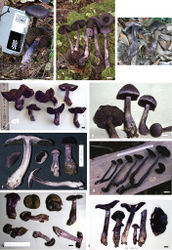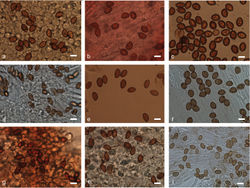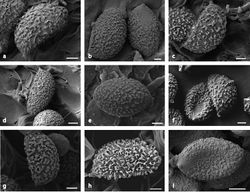Cortinarius atrotomentosus
| Notice: | This page is derived from the original publication listed below, whose author(s) should always be credited. Further contributors may edit and improve the content of this page and, consequently, need to be credited as well (see page history). Any assessment of factual correctness requires a careful review of the original article as well as of subsequent contributions.
If you are uncertain whether your planned contribution is correct or not, we suggest that you use the associated discussion page instead of editing the page directly. This page should be cited as follows (rationale):
Citation formats to copy and paste
BibTeX: @article{Harrower2015MycoKeys, RIS/ Endnote: TY - JOUR Wikipedia/ Citizendium: <ref name="Harrower2015MycoKeys">{{Citation See also the citation download page at the journal. |
Ordo: Agaricales
Familia: Cortinariaceae
Genus: Cortinarius
Name
Cortinarius atrotomentosus Harrower sp. nov. – Wikispecies link – Pensoft Profile
Diagnosis
Similar to Cortinarius violaceus (L.: Fr.) Gray but differs by having smaller spores and shorter basidia as well as an absence of caulocystidia. Unique molecular synapomorphies at pos. 71 (ITS1), and 606 (ITS2) are present in our alignment.
Type
USA, Florida: Wakulla Co., Crawfordville, Apalachicola National Forest (30°12'06"N; 84°26'33"W), on soil under Quercus virginiana, 4 Dec. 2010, TFB 13848, (holotype: TENN 065527).
Etymology
Meaning ’dark-tomentose’ in reference to the dark coloration of the fruiting body.
Description
Pileus 26–91 mm wide, surface dry, tomentose to fine scaly, dark violet (17F3) to dark brown in age (7F3), red in KOH. Lamellae adnexed, not sinuate, close to subdistant, thin, ventricose, dark violet (17F3). Stipe 75–131 mm long, 8–18 mm thick at apex, 17–26 mm thick at base, ventricose, silky-glabrous, olive brown (4E6) to brownish grey in age (5D2). Basal mycelium lilac (16B4) to greyish magenta (14D3). Context purple grey (13E2) to reddish brown (10D4). Smell mild. Taste none. Basidiospores (9–) 10.5–13 (–14.0) µm × (6–) 7–8 µm, means = 10.5–12 µm × 6–8 µm, Q = 1.43–1.67, Q means = 1.50–1.53, (70 spores, three specimens), ellipsoid to amygdaloid, strongly verrucose, plage present under SEM. Basidia 4-spored, clavate, 20–30 × 10–12 µm. Cheilocystidia abundant, narrowly fusiform to lageniform, brown in KOH, 50–70 (–80) µm × 15–25 µm. Pleurocystidia abundant, narrowly fusiform to lageniform, brown in KOH, 43–65 (–70) × 15–20 µm. Caulocystidia not seen. Pileipellis a trichoderm, hyphae 6–20 µm wide, 185–370 µm high, multiseptate, brown content in KOH, terminal hyphae mainly blunt-ended, some lanceolate or aciculate. Clamp connections present.
Ecology and distribution
Under Quercus virginiana. Known only from Apalachicola National Forest, Crawfordville, Florida, USA. Fruiting early December.
Other specimens examined
USA. Florida: Wakulla Co., Crawfordville, Apalachicola National Forest (30°12'07"N; 84°26'33"W), (Quercus virginiana), 2 Dec. 2010, D.Lewis & B.Petty TFB 13840 (TENN 065527).
Discussion
Cortinarius atrotomentosus sp. nov. was treated as ‘Cortinarius sp. NA1’ in Harrower et al. (2015)[1]. This species can be differentiated from Cortinarius violaceus by its dark violet to dark brown pileus and the olive brown to brownish grey stipe. The context of Cortinarius violaceus is violet to greyish, not mauve as is Cortinarius atrotomentosus sp. nov. Caulocystidia were not found on this species whereas they are present in Cortinarius neotropicus sp. nov. and Cortinarius violaceus. The current Gulf Coast geographic distribution of Cortinarius atrotomentosus sp. nov., where it associates with Quercus, does not overlap with the more northerly distribution of Cortinarius violaceus. The species differs from Cortinarius palatinus sp. nov., with which it appears to be most closely related (Fig. 1), by its location (Gulf Coast region) and its dark exterior. The basal mycelium is the only part of the fruiting body that could be described as pale violet.
Original Description
- Harrower, E; Bougher, N; Winterbottom, C; Henkel, T; Horak, E; Matheny, P; 2015: New species in Cortinarius section Cortinarius (Agaricales) from the Americas and Australasia MycoKeys, (11): 1-21. doi
Images
|
Other References
- ↑ Harrower E, Bougher N, Henkel T, Horak E, Matheny P (2015) Long-distance dispersal and speciation of Australasian and American species of Cortinarius sect. Cortinarius. Mycologia 107(4): 697–709.



